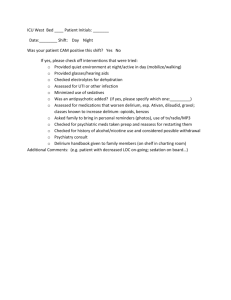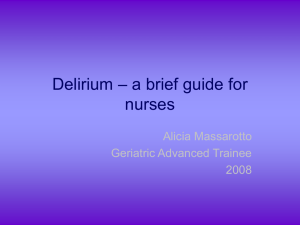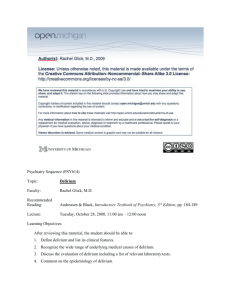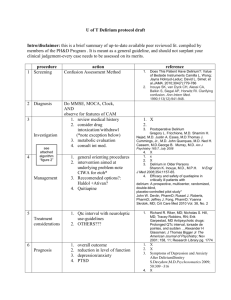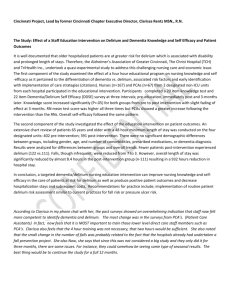Delirium Mini-Lecture June 2013
advertisement
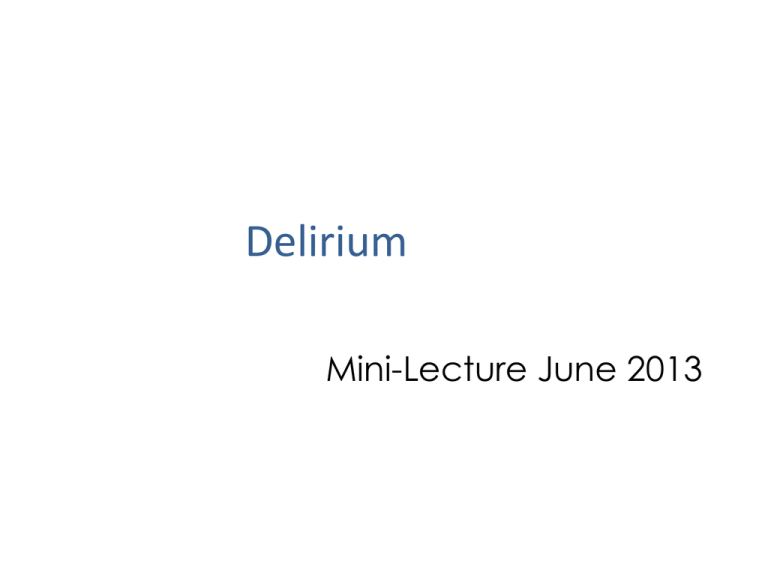
Delirium Mini-Lecture June 2013 Objectives • Discuss various causes of delirium • Review diagnostic tests in the work-up of delirium Case • 75 y/o M with DMII, COPD, and obesity is hospitalized for a hip fracture. Patient was doing well post-operatively with adequate pain management and rehabilitation. On POD #3, he forgets where he is, becomes more lethargic, and refuses to eat. Patient’s temperature is 38.5, HR 105, RR 12, 90% on 2L NC. • What are the possible causes of this change in mental status? Definition of Delirium • Altered consciousness and cognition with the following characteristics: – Poor attention – Develops over hours to days and fluctuating course during the day. – Disturbance is likely from medical condition, substance intoxication, or medication side effect. – Unlikely due to preexisting, established, or evolving dementia. Delirium • 10-20% of all hospitalized adults • 30-40% of elderly hospitalized patients • 60% to 80% of mechanically ventilated ICU patients • 50% to 70% of non-ventilated ICU patients Delirium in older patients, Francis et al., Journal of the American Geriatrics Society. 1992;40(8):829 Does delirium contribute to poor hospital outcomes? A three-site epidemiologic study. Inouye SK et al., J Gen Intern Med. 1998;13(4):234. Pointers on Assessment • ABCs and vitals first! Check GCS. • Try to obtain collateral information from family or hospital staff • Get an understanding of patient’s baseline mental status • What were the circumstances around the time of change in mental status? • What is the duration of change? • Has it happened before? • What does the family think is going on? AEIOU-TIPS mnemonic A Alcohol, Ammonia Examples Possible Diagnostic Tests • • • • alcohol intoxication/withdrawal elevated ammonia (hepatic encephalopathy) • alcohol level serum osmolality (toxic alcohols) ammonia E Electrolytes/ Endocrine • • • • • • hypoglycemia hypo/hypernatremia hypercalcemia hypo/hyperthyroidism addisonian crisis DKA/HHNS • • • • • glucose serum osmolality (HHNK) serum electrolytes (esp Na, Ca) thyroid function tests serum cortisol level I Iatrogenic • • • steroid psychosis anticholinergics in elderly, opiates, benzos • levels of medications (anticonvulsants, digoxin, theophylline,etc) drug screen (street drugs, sedatives, narcotics) • O Oxygen, opiates, obstruction U Uremia • • • • pneumonia, PE carbon monoxide opiate narcosis • • • oxygen ABG CXR • BUN AEIOU-TIPS mnemonic Examples Possible Diagnostic Tests • • • • • • Head CT/ cervical spine CT X-ray of any areas with trauma or deformity MRI/MRA if indicated concussion TIA/CVA Hematoma T Trauma I Infection • • • • • CBC with differential Urinalysis and culture (UCG if appropriate) Blood cultures and gram stain Chest X-ray Lumbar puncture (with opening pressure) - CT first if you suspect increased ICP P Poisoning • • • • Levels of medications (anticonvulsants, digoxin, theophylline,etc) Drug screen (street drugs, sedatives, narcotics) Alcohol level Serum osmolality (toxic alcohols) • • Check anticonvulsant level EEG/ MRI if indicated S Seizures Case • Patient could have multiple causes of his delirium. A few of the possibilities include: – Infection given patient’s temperature and HR (common post-op infections such as UTI and PNA) – Opiate toxicity given RR and O2 sat – Electrolyte imbalance – Hypoglycemia is possible if pt is on insulin and has decreased po intake Summary • Delirium is common in hospitalized patients and portends a poor prognosis. • Try to obtain collateral information • Use mnemonic AEIOU-TIPS to help determine etiology and useful diagnostic tests
